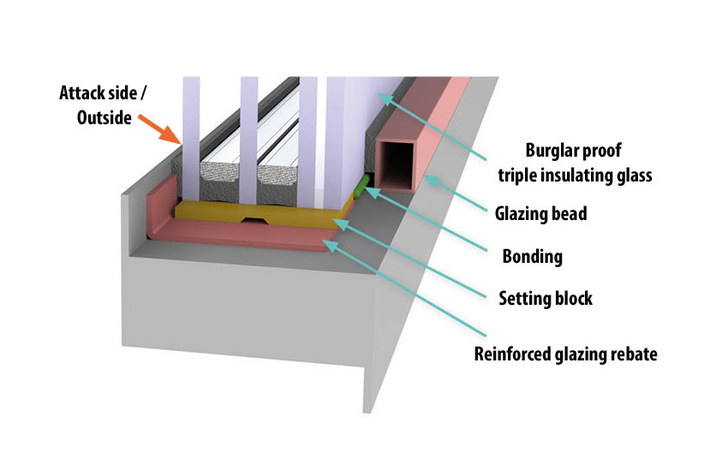What use is a solidly constructed frame if it is insufficiently fixed to the masonry? Among other things, it loses its rigidity or can actually be rammed out of the masonry, as proven by burglaries in jewellery shops where vehicles were used as battering rams.
What good is the best dowel for frame assembly if the hardware is undersized and the mushroom pins can be broken out of their latches? What good is the highest quality fitting if the wrong glass has been chosen and the glass pane can be broken through within a very short time?
A penetrable opening can be enough to open the window or clear out the window display of a shop. These are only a few possible weaknesses that must be considered when planning a comprehensive burglary protection concept. And these examples clearly show that glazing must be considered and dimensioned as a system.
Every detail in the security chain matters
Therefore, for each step of construction, the optimally suitable system must be selected. Every detail in the security chain has its part to play in whether an overall system is secure and burglary-resistant in an emergency. Or not. As the saying goes: Every chain is only as strong as its weakest link.
Often neglected, not considered or incorrectly executed is the glass connection, i.e. the connection of glass to frame. This area plays a decisive role in whether or not the door, window or facade element can withstand an attack.
How secure is the link of glass and frame?
The glass connection contributes significantly to the rigidity of the frame and/or the sash. If a frame can be twisted, fittings can be levered out or broken. The blocking, the security glass itself and also the glazing system have an impact on the rigidity: The glass can be glued into the frame or also mounted with additional metal brackets.
If a burglar manages to penetrate the glazing rebate with his tool, he could break out the glass from the edge until a sufficiently large opening is created through which the fitting can be manipulated.
In addition, the frame also loses rigidity here, which, as mentioned, can allow levering or breaking out of fittings. Piercing up to and beyond the glass retaining strip mounted on the protective side must be made considerably more difficult. This applies in particular to burglary-resistant doors in escape and rescue routes.
Prevent panic doors from being manipulated
Here, even with an opening the size of a pencil in the glass or glass connection, the panic hardware on the inside of the room can be manipulated. It is therefore also necessary to protect the glass edge separately. Whether this is done by means of bonding, additional metal brackets in the glass rebate space or additional profiles on the glass edge depends on the system manufacturer and its possibilities and specifications.
From a strictly constructive point of view, the glass overlay and the glass retaining strip belong to the frame. Nevertheless, they take on an important role with regard to the glass connection: The glass overlay can already prevent penetration into the glass rebate space, as a first protective wall, so to speak.
[Seven answers for safety and security glass]
The glass retaining strip holds the safety glass in the frame and, as the last barrier, can prevent it from being pierced. Not only material thicknesses and fastening, but also the geometry of these frame elements contribute to burglar resistance.
Testing and planning burglary resistance
There are many more ways of influencing the security chain of the entire burglar-resistant element than described above. Depending on the resistance class or project-specific requirements, these are more or less extensive.
The tool sets and approaches of the inspectors in the respective resistance classes of DIN EN 1627 to 1630 have to be considered. While the choice of tools is still relatively small for RC2, the screwdriver used can still cause a great deal of damage.
From RC3, a crowbar is added as an effective lever tool. From RC4, a cordless screwdriver and an axe are used, which can cause fatal damage.
Security and design not contradictory
At RC5 and RC6, the heavy artillery in the form of electrical devices is brought in. In this case, a correspondingly high effort must be made in the construction of the window, door or facade element.
In addition to the normative requirements, project-specific burglary scenarios and special requirements should always be taken into account. Constructions with increased requirements are often correspondingly more massive. Security measures do not necessarily have to be massive: High security and attractive design are not contradictory, as some system and glass manufacturers show. For example, tested systems in the resistance class RC3 or actually RC4 are already on the market, which are outwardly indistinguishable from systems without burglary resistance.
This is how serious weak points can be avoided
As early as the product development stage, system manufacturers are required to have a high level of expertise in security glass as well as frame construction. This not only enables the desired goal to be achieved more effectively, namely successful testing and certification at the testing institutes, but also ensures user-friendly and cost-efficient development right from the start.
[Silatec security glass: Every project needs a special security solution]
Once the product development has been successfully completed and the system has been tested and certified in its resistance class, it is up to the fabricator to manufacture and install the system correctly. In doing so, it is imperative that the fabricator observes all specifications, guidelines and project-specific designs!
Glass, glass block, glass retaining strip, screw connection, bonding and system-specific elements, to name but a few, are all important components of a glass connection that can become serious weak points if processed incorrectly.
The interface between glass and frame is much more important for mechanical burglary resistance than is often assumed. It is therefore very important that all those involved in the process chain of a building element also pay full attention to the many small details. This starts with the planning, continues with the execution, and extends to the installation: even a "small" mistake in the detail can decide on the success or failure of a burglary attempt.














